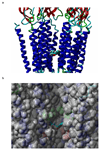Interaction of bupropion with muscle-type nicotinic acetylcholine receptors in different conformational states
- PMID: 19334677
- PMCID: PMC2756054
- DOI: 10.1021/bi802206k
Interaction of bupropion with muscle-type nicotinic acetylcholine receptors in different conformational states
Abstract
To characterize the binding sites and the mechanisms of inhibition of bupropion on muscle-type nicotinic acetylcholine receptors (AChRs), structural and functional approaches were used. The results established that bupropion (a) inhibits epibatidine-induced Ca(2+) influx in embryonic muscle AChRs, (b) inhibits adult muscle AChR macroscopic currents in the resting/activatable state with approximately 100-fold higher potency compared to that in the open state, (c) increases the desensitization rate of adult muscle AChRs from the open state and impairs channel opening from the resting state, (d) inhibits binding of [(3)H]TCP and [(3)H]imipramine to the desensitized/carbamylcholine-bound Torpedo AChR with higher affinity compared to the resting/alpha-bungarotoxin-bound AChR, (e) binds to the Torpedo AChR in either state mainly by an entropy-driven process, and (f) interacts with a binding domain located between the serine (position 6') and valine (position 13') rings, by a network of van der Waals, hydrogen bond, and polar interactions. Collectively, our data indicate that bupropion first binds to the resting AChR, decreasing the probability of ion channel opening. The remnant fraction of open ion channels is subsequently decreased by accelerating the desensitization process. Bupropion interacts with a luminal binding domain shared with PCP that is located between the serine and valine rings, and this interaction is mediated mainly by an entropy-driven process.
Figures







References
-
- Hurt RD, Sachs DP, Glover ED, Offord KP, Johnston JA, Dale LC, Khayrallah MA, Schroeder DR, Glover PN, Sullivan CR, Croghan IT, Sullivan PM. A comparison of sustained-release bupropion and placebo for smoking cessation. N. Engl. J. Med. 1997;337:1195–1202. - PubMed
-
- Wonnacott S, Barik J. Nicotinic ACh Receptors. TOCRIS Rev. 2007;28:1–20.
-
- Slemmer JE, Martin BR, Damaj MI. Bupropion is a nicotinic antagonist. J. Pharmacol. Exp. Ther. 2000;295:321–327. - PubMed
-
- Fryer JD, Lukas RJ. Noncompetitive functional inhibition at diverse, human nicotinic acetylcholine receptor subtypes by bupropion, phencyclidine, and ibogaine. J. Pharmacol. Exp. Ther. 1999;288:88–92. - PubMed
-
- Arias HR, Bhumireddy P, Bouzat C. Molecular mechanisms and binding site locations for noncompetitive antagonists of nicotinic acetylcholine receptors. Int. J. Biochem. Cell Biol. 2006;38:1254–1276. - PubMed
Publication types
MeSH terms
Substances
Grants and funding
LinkOut - more resources
Full Text Sources
Miscellaneous

